Updated: 09-Jul-2021
PZL had two main manufacturing sites, Kalisz and Rzeszow.

“Logo”
-As is common in Eastern countries and the USSR, PEZETEL was a foreign trade company for the Polish aeronautical industry.
-Reviewing this history we finally arrive at PZL. We will say that the first aircraft engine manufactured in Poland was built by Henryk Brzeski, in 1907. It was a birotary giving 70 CV.
-The building of aviation engines in that country, apart from Brzeski, began with several prototypes built in the following years which were due to E. Libanski, Kozakiewicz, T. Tanski and others. Although they were never tested in flight.
-The first Polish aviation turbine was built by Stanislaw Naskiewicz, presented at Lvov Technical University, it had a water-cooled turbine disc and 4 combustion chambers.
-Until the 1930's they acquired engines in France. These engines were repaired at the Central Aviation Factory at Motokow airport, near Warsaw.
-The “Polish Skoda Works” (PSW) factory was the first to be installed to build aviation engines.
-They started with the 400 and 450 CV Lorraine-Dietrichs and production exceeded 300 engines in 1930.
-From 1929 to 1931 more than 350 Wright J-5 Whirlwind 220 CV units were made.
-Between 1935 and 1939, 300 Whirlwind engines were manufactured by AVIA.
-PSW made the 485 CV Bristol Jupiter VIIF between 1932 and 1933 (350 units),
-And some 300 units of the Mercury IV, V, VI were produced between 1933 and 1936.
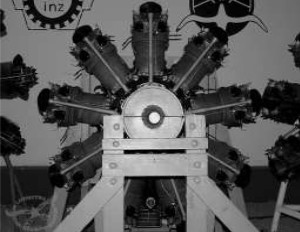
“PZL Pegaz II-M2”
-In 1935 PZL made 50 Pegasus II engines with 580 CV, and between 1936 and 1937 300 Pegasus VIII with 670 CV were made.
-In Poland the English Pegasus was called "Pegaz".
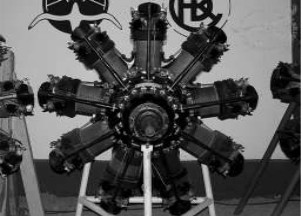
“Pegaz VII”
-Stanislaw Nowkunski was the engineer of important engines such as the G-594 “Czarny Piotrus” (Pedro el Negro), with 100 CV.
-He was responsible for the 260/290 CV GR-760 and the 410 CV GR-1620AA Mors I (Walrus I). The G-1620B was the Mors B.
-In 1935, PZS (PSW) was nationalized and changed its name to the State Aviation Factory.
-Motor Plant No. 1, in Okecie: PZL WS-1. Here the production of the previous Skoda continued.
-During 1938 and 1939, they manufactured 200 Pegasus XX with a power of 920 CV.
-In 1939, production of the Hercules engine began with 1375 CV.
-Before WWII, the prototype of the new PZL-Foka (Seal) engine of 430/600 CV was built. It had 8 cylinders in inverted V.
-The Foka II gave 650 CV. Two more models were designed at this time.
-These were the PZL-Waran (Monitor-Lizard), a radial that gave 800/1,200 CV, and the PZL Leguran (Iguana) that gave 2,000 CV.
-J. Oderfeld was testing turbines within the company itself.
-The PZL factories in Ursus, near Warsaw, made 600 units of the 110CV PZL Junior and 100 units of the 130CV PZL Major (Typ 4) under Walter license. Note: see PZ-Inz.

“PZL, Junior”
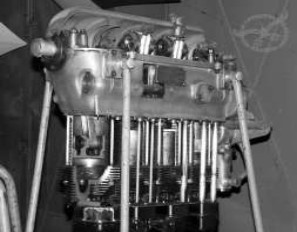
“PZL, Major”
-Some of the PZL engine pictures have been taken at the Krakow Museum.
-In 1937 the new Rzeszow factory, No. 2, began to build Walter's Junior and Major as well.
-During World War II, the Germans removed the machine tools from factory No. 1 and blew it up.
-After the war, the Rzeszow factory was dedicated to the repair of the M-11, WK-105 and AM-38 engines.
-In 1946 the Central Aircraft Study (CSS, Centralne Studium Samolotów) was established.
-They set up a team led by W. Narkiewicz that made a derivative project from Walter, and soon the 65 CV WN-1 appeared. This engine was first tested on a Piper.
-The NP-1 was developed around 1958 and was another version of the WN-1.
-The second engine was a 7-cylinder radial, the 280 CV WN-2.

“PZL, NP-1”
-The M-11 was introduced for mass production in 1948.
-The M-11D variant appeared in 1949 and the M-11FR in 1950.
-In 1952 another WSK factory was established in Kalisz, where more than 1500 units of the M-11 were made.
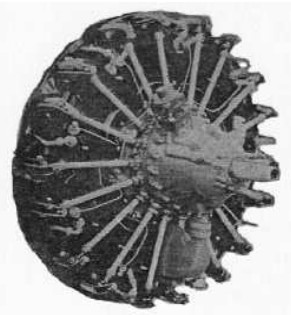
“PZL, AI-14R”
-Russian aircraft and helicopter licensing introduced the construction of the Ivchenko AI-14R, 200 CV radials in Kalisz, later the improved AI-14RC version was made.
-They were used on the Wilga, the Gawron and the Yak 12M.
-Shvetsov's ASz-62R engine with 1000 CV was also manufactured at the Kalisz factory. It was a 9-cylinder developed from the Wright R-1820 by Arkadiya Shvetsov in his OKB in the Soviet Union.
-In Poland it was mounted on the An-2 and between 1961 and 1971 more than 10,000 of these engines were manufactured.
-Later we would see them on the Dromaders that were used for fumigation and fire fighting.
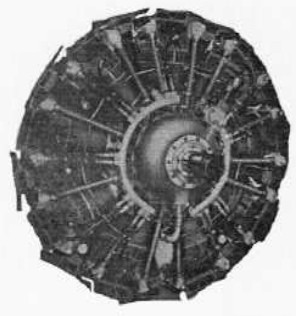
“PZL, Asz-62IR”
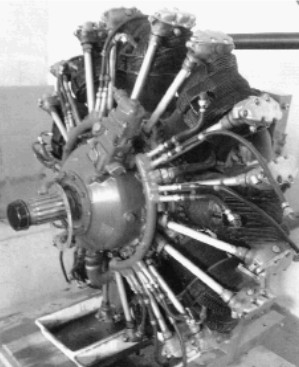
“Sh-62IR engine”
-The Asz-62IR engine is built under license from the Russian (and Soviet) Sh-vetsov Sh-62IR.
-Precisely the engine shown in the lower illustration above is located at the Historical Memory Interpretation Center in La Senia (Tarragona, Spain).
-Variants such as the -TK with a turbocharger were made to maintain the 850 CV at 9,500 meters altitude (31,000 feet).
-The fact that the new factories were known as WSK refers to Wytwornia Spretzu Komunicacy Jnego (Later comes the initial PZL-Kalisz or Rzeszow). WSK is Transportation Equipment Manufacturing Center.
In the early 1950's, the engine production for the Polish LIM-1 (MiG-15) aircraft began.
-The first 30 RD-10A units (900 Kgf of thrust) were the WK-1 (or LIS-1).
-The WK-1A (LIS-2) started in 1954 and the WK-1F (LIS-5) started in 1956.
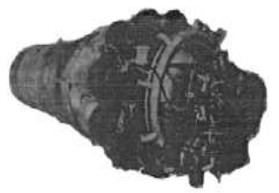
“LIS-2 = WK-1A”
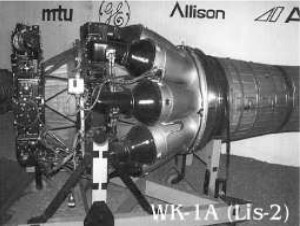
“At the Krakow Museum”
-In 1952, the WN-3 with 7 radial cylinders and a power of 320 CV was put into production at the WSK-PZL factory in Kalisz.
-The helicopter version was the WN-4 (see again W. Narkiewicz). The K-5 did not go into production.
-The K-8AA was a 9-cylinder radial based on the Veedeneyev / Ivchenko M-14PM. The K-9 was made too.
-The WN-6, a 185 CV horizontally-opposed 6-cylinder engine, was built at WSK-PZL in Okecie.
-Pulsejets with and without valves, as well as ramjets were tested.
-The former ones were tested on the Bocian-Puls glider. The latter ones on the Pe-2 and JK-1.
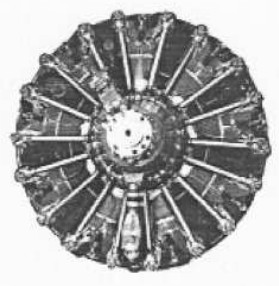
“PZL, K-8AA”
-The first experimental Polish turbojet was built in Rzeszow.

“Rzeszow logo”
-It was known as TO-350 and it delivered 350 Kgf. It was followed by the HO-10 with 800 Kgf of thrust.

“PZL, SO-1”
-In the early 1960's, they began with the SO-1. In fact the design started at the Aeronautical Institute in Warsaw in 1958.
-The first flights began in 1964 and its manufacture around 1967.
-It delivered 1,000 Kgf of thrust and was intended for the Iskra TS-11.

“SO-1 at the Krakow Museum”
-But it was the SO-3 that was eventually used and that was the version that followed the SO-1.
-In 1971, they started to build them in Rzeszow.
-A modified version, the SO-3B was tested in 1975. (See IL).
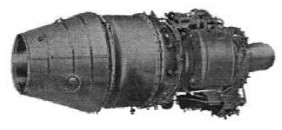
“SO-3”
-The LIT-3 radial engine was the one built under license from the Ivchenko AI-26W. Later the 3S came out.
-The LIT-3 began to be manufactured in 1958 and was destined as a power plant for the Mi-1 helicopter.
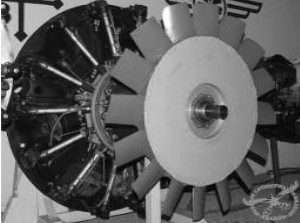
“LIT-3 at the Krakow Museum”
-The photograph above shows the fan that is necessary for helicopter hovering.
-As has been said, the derivative is the LIT-3S with 600 CV at 2,200 rpm and 415 CV at 2,000 rpm.
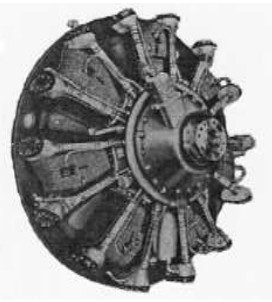
“LIT-3S”
-Below, we show two cutaways for a LIT-3.
-Difficult to see but certainly more than interesting documents.
-The first a LIT-3S, in a side view in which we can see the accessories well separated -which is to be appreciated in maintenance-. The lower one is the geared LIT-3SR.
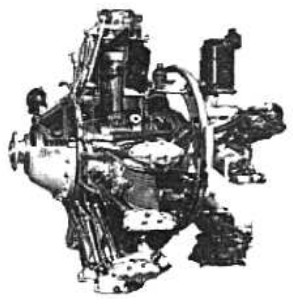
“LIT-3S, cutaway”

“LIT-3SR, cutaway”
-In turboprops / turboshafts there is an unknown TG-16, a possible predecessor of the GTD-350, perhaps.
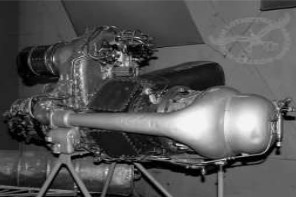
“TG-16”
-The semblance of its architecture with the mentioned GTD-350 and this one with the Allison 250 is suspiciously similar, although it is not clear which came first.
-The GTD-350 were Isotov's licensed turboshafts. They began to build them in Rzeszow in 1966.
-Two of these engines powered the Mi-2.
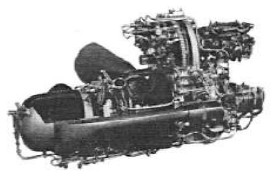
“TD-350, cutaway”
-Later in 1974, PZL made a new version, the GTD-350P for 450 CV at takeoff and with the intention of being used in both tropical and arctic environments.
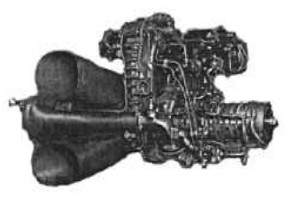
"GTD-350, with impressive exhausts"
-They were designed with the provision for multiple exhaust outlets (see TG-16 photo), it could be installed either on the port or starboard side of the helicopters.
-The Russian-licensed PZL-10 was designed by Glushenkov (the TVD-10B turboprop).
-The correct denomination in Poland was the PZL10S. It was manufactured at the Mielec WSK-PZL.
-The PZL-10W variant was mounted in pairs on the Sokol helicopter. They gave 870 CV of power to the shaft.
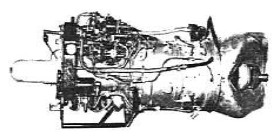
“PZL-10W”
-In 1975, PZL acquired the licenses to make a select group of American engines to be manufactured under license.
-It is the Franklin Aircooled Motors brand.
-They have been built in the Reszow factory for a range of Piper aircraft also manufactured under license apart from other native aircraft such as the Ogar, Mielec, Mewa or Koliber.

“PZL, F-2A-120C”
-The smallest is the 2A, with two horizontally-opposed cylinders and 117 cubic inches of displacement delivering 60 CV at takeoff.
-The 4A-235B had four horizontally-opposed cylinders and 235 cubic inches of total displacement, (3850 cc).
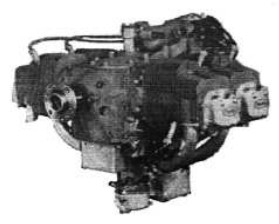
“PZL-4A”
The 6-cylinder engines in the same range are divided into two different displacements, 335 cu. in. and 350 cu. in.
-The 335s have been the 6A-335 series with 6 horizontally-opposed cylinders, giving 180 CV of power at 2,800 rpm and the turbocharged 6AS-335 gave 260 CV from sea level to 3,000 meters above sea level.
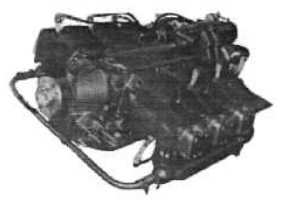
“PZL, F-6A”
-The most typical were the 350 cu. in. C and D series engines giving 220 CV and 235 CV respectively.
-The turbocharged 6AS-350A delivered 250 CV.
-Later, the K-15 came out for the Iryda trainer and the D-18A, which has nothing to do with the large Russian Lotarev D18T engines, but with small turbofans of almost 4,000 lbf of thrust.

“PZL, K-15”
-Earlier in this chapter the Mors is mentioned. The Rwd-14 aircraft was powered by the 9-cylinder Mors II, 470 CV G-1620B.
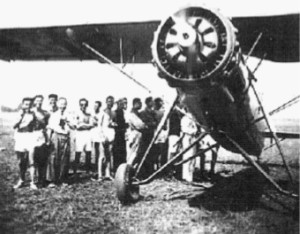
“The Mors installed”
-The Mors G-1620 (without ending letter) gave 330 CV and was seen on the RWS-28.
-The PZL engines with their own name were mainly:
-The ”Legwan” P-50A with 1400/1500 CV (seen on the Jastrzeb from 1939).
-The “Iguana” with 18 cilindros giving 900/1000 CV.
-The “Waran” with 1400/1600 CV.
-The “Foka”.
-The “Urzsus”.
-The “Walrus”.
-The “Mamut”.
From Appendix 9: Several engines of this brand have been located at a Museum in the country where they were manufactured, in Poland.

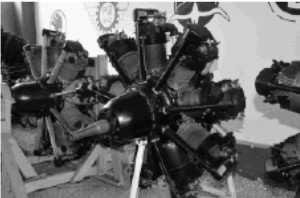
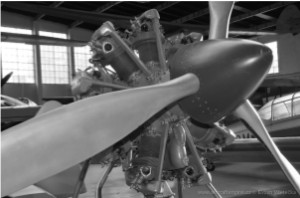
“Pegaz II M2, VIII and XX”
-The Pegaz engines are licensed from the Bristol Pegasus model in its variants.
-We have a new photograph from the NAC (PiP) file showing a PZL engine which, due to the fact that it is a nine-cylinder radial and has asymmetric superimposed reduction gear, is undoubtedly the 290 CV GR-760 CV.
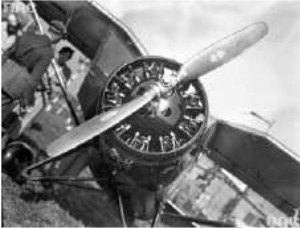
“GR-760 engine installed on an aircraft” (PiP)
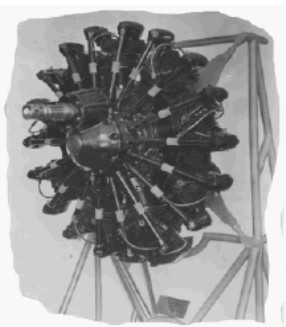
“El GR-760 con la reductora bien visible”
-PZL and perhaps IL (see). A relatively modern turbine with by-pass and suitable for afterburner with the designation PZL-5DA with 1840 daN.

“PZL-5DA”
From Appendix 10: We obtained a little more information about the “Foka”, an 8-cylinder inverted-V engine and the airplane that used it.

“Twin engine aircraft with two PZL Fokas”
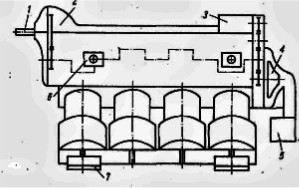
“Foka engine schematic drawing”
-Clearly a geared, air-cooled, inverted V8 with mechanical supercharger.
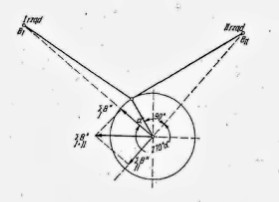
"Foka calculations (from a study)"
-Naturally the angles of the cylinder blocks were at 90° coinciding with the geometric angle.
From Appendix 13: Color photo of the 6-cylinder engine manufactured by PZL when it was the manufacturer of American Franklin engines. PZL became the owner of the brand.
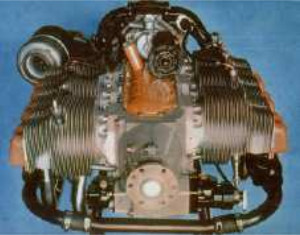
“On the top left, the turbo. Total 6 cylinders”
-The duct that we see in front of the engine joining the two cylinder rows, is an intake and is used to balance the same intake pressure for both sides. We also see them on the Continental 0-470 and O-520.
Engines of PZL
Model: AI-14R
Arquitecture:
Cooling:
Total Displacement:
Bore / Stroke: x
Power:
Weight:
Model: ASz-62, -62R, -62-IR
Arquitecture:
Cooling:
Total Displacement:
Bore / Stroke: x
Power:
Weight:
Model: Brzeski, 70 HP
Arquitecture:
Cooling:
Total Displacement:
Bore / Stroke: x
Power:
Weight:
Model: D-18A
Arquitecture:
Compressor/s:
Combustion chambers:
Turbines:
Power / Thrust: / ---
Weight:
Model: F-2A, Franklin
Arquitecture:
Cooling:
Total Displacement:
Bore / Stroke: x
Power:
Weight:
Model: F-4A, Franklin
Arquitecture:
Cooling:
Total Displacement:
Bore / Stroke: x
Power:
Weight:
Model: F-6A, V, Franklin
Arquitecture:
Cooling:
Total Displacement:
Bore / Stroke: x
Power:
Weight:
Model: Foka, I, II
Arquitecture:
Cooling:
Total Displacement:
Bore / Stroke: x
Power:
Weight:
Model: G-R 1620-AA Lic., Mors I
Arquitecture:
Cooling:
Total Displacement:
Bore / Stroke: x
Power:
Weight:
Model: G-R 1620-B Lic., Mors B
Arquitecture:
Cooling:
Total Displacement:
Bore / Stroke: x
Power:
Weight:
Model: G-R 760 (Li
Arquitecture:
Cooling:
Total Displacement:
Bore / Stroke: x
Power:
Weight:
Model: GTD-350 (Lic.)
Arquitecture:
Compressor/s:
Combustion chambers:
Turbines:
Power / Thrust: / ---
Weight:
Model: HO-10
Arquitecture:
Compressor/s:
Combustion chambers:
Turbines:
Power / Thrust: / ---
Weight:
Model: J-5 Whirlwind (Lic.)
Arquitecture:
Cooling:
Total Displacement:
Bore / Stroke: x
Power:
Weight:
Model: Jupiter (Lic.)
Arquitecture:
Cooling:
Total Displacement:
Bore / Stroke: x
Power:
Weight:
Model: K-15
Arquitecture:
Cooling:
Total Displacement:
Bore / Stroke: x
Power:
Weight:
Model: K-5
Arquitecture:
Cooling:
Total Displacement:
Bore / Stroke: x
Power:
Weight:
Model: K-8AA
Arquitecture:
Cooling:
Total Displacement:
Bore / Stroke: x
Power:
Weight:
Model: K-9
Arquitecture:
Cooling:
Total Displacement:
Bore / Stroke: x
Power:
Weight:
Model: Legwan, P-50A
Arquitecture:
Cooling:
Total Displacement:
Bore / Stroke: x
Power:
Weight:
Model: LiS-1
Arquitecture:
Compressor/s:
Combustion chambers:
Turbines:
Power / Thrust: / ---
Weight:
Model: LiS-2
Arquitecture:
Compressor/s:
Combustion chambers:
Turbines:
Power / Thrust: / ---
Weight:
Model: LiS-5
Arquitecture:
Compressor/s:
Combustion chambers:
Turbines:
Power / Thrust: / ---
Weight:
Model: LiT-3, -S, -SR
Arquitecture:
Cooling:
Total Displacement:
Bore / Stroke: x
Power:
Weight:
Model: Lorraine Dietrich (Lic.)
Arquitecture:
Cooling:
Total Displacement:
Bore / Stroke: x
Power:
Weight:
Model: M-11 (Lic.)
Arquitecture:
Cooling:
Total Displacement:
Bore / Stroke: x
Power:
Weight:
Model: Mamut
Arquitecture:
Cooling:
Total Displacement:
Bore / Stroke: x
Power:
Weight:
Model: Mercury (Lic.)
Arquitecture:
Cooling:
Total Displacement:
Bore / Stroke: x
Power:
Weight:
Model: NP-1
Arquitecture:
Cooling:
Total Displacement:
Bore / Stroke: x
Power:
Weight:
Model: Pegasus II, VIII, XX (Pegaz) (Lic.)
Arquitecture:
Cooling:
Total Displacement:
Bore / Stroke: x
Power:
Weight:
Model: PZL-10, -S, -W
Arquitecture:
Compressor/s:
Combustion chambers:
Turbines:
Power / Thrust:
Weight:
Model: PZL-3
Arquitecture:
Cooling:
Total Displacement:
Bore / Stroke: x
Power:
Weight:
Model: PZL-5DA
Arquitecture:
Compressor/s:
Combustion chambers:
Turbines:
Power / Thrust: / ---
Weight:
Model: SO-1
Arquitecture:
Compressor/s:
Combustion chambers:
Turbines:
Power / Thrust: / ---
Weight:
Model: SO-3, -B
Arquitecture:
Compressor/s:
Combustion chambers:
Turbines:
Power / Thrust: / ---
Weight:
Model: TG-16
Arquitecture:
Compressor/s:
Combustion chambers:
Turbines:
Power / Thrust: / ---
Weight:
Model: TO-350
Arquitecture:
Compressor/s:
Combustion chambers:
Turbines:
Power / Thrust: / ---
Weight:
Model: Ursus
Arquitecture:
Cooling:
Total Displacement:
Bore / Stroke: x
Power:
Weight:
Model: Walrus
Arquitecture:
Cooling:
Total Displacement:
Bore / Stroke: x
Power:
Weight:
Model: Walter Junior (Lic.)
Arquitecture:
Cooling:
Total Displacement:
Bore / Stroke: x
Power:
Weight:
Model: Walter Major (Lic.)
Arquitecture:
Cooling:
Total Displacement:
Bore / Stroke: x
Power:
Weight:
Model: Wara
Arquitecture:
Cooling:
Total Displacement:
Bore / Stroke: x
Power:
Weight:
Model: WN-1
Arquitecture:
Cooling:
Total Displacement:
Bore / Stroke: x
Power:
Weight:
Model: WN-2
Arquitecture:
Cooling:
Total Displacement:
Bore / Stroke: x
Power:
Weight:
Model: WN-3
Arquitecture:
Cooling:
Total Displacement:
Bore / Stroke: x
Power:
Weight:
Model: WN-6
Arquitecture:
Cooling:
Total Displacement:
Bore / Stroke: x
Power:
Weight:
Model: WS-1
Arquitecture:
Cooling:
Total Displacement:
Bore / Stroke: x
Power:
Weight:


